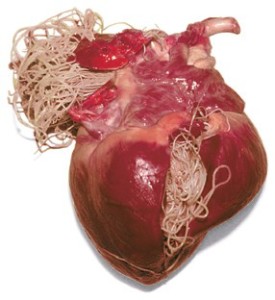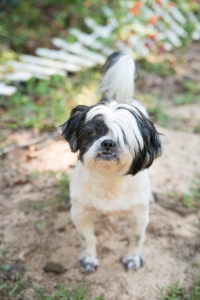May 13, 2015 / by Leann / Make A Comment / Filed under Uncategorized
T he major culprits: trees, grasses, pollens, molds and ragweed. The main cause: inhaling these irritants through the nose and mouth.
he major culprits: trees, grasses, pollens, molds and ragweed. The main cause: inhaling these irritants through the nose and mouth.
Unlike humans, most dogs’ allergies manifest themselves as skin irritations or inflammations known as allergic dermatitis. Left untreated, your dog’s constant scratching can lead to open sores and scabs, hair loss and hot spots. Ear infections, running noses, watery eyes, coughing and sneezing may also occur.
To determine the source of your dog’s allergy, ask your vet to conduct a series of tests: intradermal, blood or both.
Once a specific allergen has been identified, you can try the following:
Avoidance: for pollens, keep your dog away from fields; keep lawns short; keep her indoors when pollen counts are high; vacuum and wash floors with non-toxic agents instead of regular household cleaners containing chemicals.
Topical therapies: frequent baths with an oatmeal-free shampoo; foot soaks to reduce tracking allergens into the house; topical solutions containing hydrocortisone to ease the itching.
Diet: one low in carbohydrates like grain, or low in fat; put omega-3 fatty acids and/or coconut oil in her food; add a combination of the naturopathic supplements quercetin, bromelain and papain to her meals.
Drugs: antihistamines, cyclosporine or steroids.
As always, consult your vet before starting any form of treatment. Monitor your dog’s behaviour closely and report any improvement or worsening in her condition.
It may take several attempts before the proper treatment is found. But when it is, your dog will be much more comfortable — and so will you.
Author: Nomi Berger
April 21, 2015 / by Leann / Make A Comment / Filed under Uncategorized
 A single bite from a single infected mosquito can cause an otherwise healthy dog to develop heartworm disease and potentially die.
A single bite from a single infected mosquito can cause an otherwise healthy dog to develop heartworm disease and potentially die.
A heartworm is a parasitic worm (Dirofilaria immitis) that lives in the heart and pulmonary arteries of an affected dog. The worms travel through the bloodstream, damaging arteries and vital organs as they go, before arriving at the lungs and heart approximately six months after that initial mosquito bite. Several hundred worms can live in a single dog from between five and seven years, and if left untreated, can prove fatal.
The best protection against this insidious disease? Prevention. Prevention is both safe and effective, whereas treating the disease itself is complicated, costly, and can, like the disease, have serious, even fatal, effects on the stricken dog.
Preventives work by killing the heartworm larvae before they can grow and mature into adult heartworms. Although a variety of preventives are now available to conscientious pet owners everywhere, the first step in the prevention process is a visit to the vet.
Most vets recommend yearly testing for heartworm in dogs older than 6 months, usually in late spring. If your dog is heartworm negative, inexpensive, chewable pills are available with your vet’s prescription. The pills, which are palatable to most dogs, must be given to your dog monthly and are manufactured by several companies. These pills can also be given to dogs under 6 months of age without a blood test.
Besides pills, there are specially designed, chemical preventive products that you apply directly onto your dog’s skin. Some heartworm preventives contain additional ingredients that will control other parasites, such as roundworms or hookworms, while the topical preventives prescribed by your vet will protect your dog against fleas and ticks as well.
If you choose the vet-prescribed pill, you can opt to give it to your dog only during mosquito season (from spring through the first frost), but the most recent recommendation from the American Heartworm Society is to keep giving them all year round. And remember, although your dog may not go outside, mosquitoes can still get INside.
For those preferring to NOT use either the pill or the topical preventive, homeopathic veterinarians advise testing your dog for heartworm twice yearly.
In short, consult with your vet. Protect the dog you love against these invasive, potentially fatal parasites, and this summer all of you can rest, assured.
Author: Nomi Berger
April 15, 2015 / by Leann / Make A Comment / Filed under Uncategorized
 “Every sixty seconds, an animal is abused.”
“Every sixty seconds, an animal is abused.”
This, according to the ASPCA. And so, they have designated April as “Prevention of Cruelty to Animals” Month. They have also urged their supporters everywhere to “Go Orange for Animals” to increase public awareness.
The following are ways YOU can help.
START A FUNDRAISING CAMPAIGN
Using your personal Facebook account, create an ASPCA fundraising page for an important event in your life and share it with friends and family. Whether you “donate” your birthday, honor the memory of a beloved pet or run a 5k with Team ASPCA, the money you raise will benefit needy animals nationwide.
SUPPORT A LOCAL ANIMAL SHELTER OR RESCUE GROUP
Drawing on your own, personal contacts, team up with a local shelter or rescue in sponsoring a ”Go Orange for Animals” event (wearing orange, of course). Whether it’s an adoption event or a donation drive, give them the proceeds and/or supplies you’ve collected, and know the difference you’re making is huge!
SHOW YOUR VIRTUAL SUPPORT
Spread the word about “Prevention of Cruelty to Animals” Month by posting on your social media networks using the hashtag #fightcruelty and tagging @aspca. Encourage your family and friends to follow the ASPCA on Facebook, Twitter, Instagram and Pinterest.
BECOME AN ANIMAL ACTIVIST
Visit the ASPCA Advocacy Center online, join their Advocacy Brigade to receive emails about important animal welfare-related legislation, and learn how YOU can become a voice for the voiceless.
MAKE ADOPTION YOUR FIRST OPTION
Looking for the perfect fur friend for your family? Both shelters and rescue groups have loving dogs and cats of all breeds, ages and colors, desperate to find their own perfect families. By adopting, not shopping, you’re saving two lives: the life of the animal you adopt and the life of the animal taking its place.
How To Report Animal Cruelty
If you witness the act yourself, you can go to your local police commissioner and ask to swear out a warrant summoning the accused person to court.
Or you can find out precisely where to report the incident in your area. Then, either call or email them, providing a concise, factual statement of what you observed,
including the date and approximate time of the abuse.
If possible, photograph the abusive situation and date your pictures.
If possible, gather brief, factual written statements from other witnesses.
If you have documents pertinent to your complaint, always make copies for your own records before giving them to anyone else.
If you call to report a case of animal cruelty, keep a record of the person you contact, the date, and the content and outcome of your discussion. Make it clear that you are interested in pursuing the case, and that you will help in any way you can.
If you don’t receive a response from the agent/officer assigned to your case within a reasonable length of time, follow up. Present your information to his/her supervisor and, if necessary, to local government officials, such as the county commissioner, and ask them to act.
Remember. If YOU don’t speak up, this abuse is likely to happen again.
Author: Nomi Berger
April 11, 2015 / by Leann / Make A Comment / Filed under Uncategorized
 More and more outdoors events are being cancelled, more and more dogs are being affected, and more and more Midwestern cities are bracing for the worst.
More and more outdoors events are being cancelled, more and more dogs are being affected, and more and more Midwestern cities are bracing for the worst.
Health officials, especially in the Chicago area, have cautioned dog owners that a recent surge in the number of reported cases of canine flu could continue for SEVERAL weeks.
According to the Cook County Department of Animal and Rabies Control, veterinarians have already identified over 1,000 cases of Influenza or H3N8, including some deaths.
Although sick dogs can be asymptomatic, they are still contagious, and dog owners are being warned to avoid dog parks and to keep their dogs away from other dogs. Because the virus can spread so easily from dog to dog, shelters and sanctuaries, day cares and boarding kennels are especially concerned and particularly at risk.
Both Bordetella and the flu virus have symptoms that mimic each other. Symptoms of the flu include persistent coughing, dry cough, fever, nasal discharge, lack of energy, and loss of appetite. In about 20 percent of cases, more severe symptoms can occur, including high fever and pneumonia. A small number of dogs can also die from complications of the disease.
Canine flu, which first appeared in dogs in 2005, is NOT contagious to humans and WON’T spread to cats, but people who have been in contact with a dog infected by the virus CAN inadvertently spread it to their own and other dogs. Careful hand washing after petting a dog, any dog, may help to slow the spread somewhat.
Although outbreaks occur then dissipate unpredictably, the good news is that there is now a vaccine for your dog available from your veterinarian.
For more information, please visit: http://www.cdc.gov/flu/canine/
February 24, 2015 / by Leann / Make A Comment / Filed under Uncategorized
 Their bodies may be imperfect, but their spirits remains intact.
Their bodies may be imperfect, but their spirits remains intact.
So it is said about the special needs dog. Although caring for one can be challenging, more and more people are opening their hearts and their homes and adopting them. For this reason, more and more dogs who might otherwise be euthanized are being given a new “leash” on life.
Experts stress the importance of not viewing special needs dogs as “handicapped.” Although they have certain limitations (including partial paralysis, three leggedness, blindness or deafness), they’re not “aware” of them, and can be as active and affectionate as any other dog.
Adopters of special needs dogs insist the rewards outweigh the work. Many use social media to share their experiences, to interact with owners like them, and to encourage others to adopt. They don’t see these dogs’ medical or physical problems as a shortcoming, and don’t believe it makes them any less of a dog.
Those interested in adopting a special needs dog should first fully inform themselves about that dog’s condition, limitations, and maintenance. This includes meeting with their vet, requesting a tutorial on administering medications, and asking if they will make house calls. If not, they should ask to be referred to someone who will.
The quality of life for special needs dogs has been greatly enhanced by the growing number of products available to their owners. There are pet diapers, no-slip boots, orthotic braces, prosthetics, and front, back, combination and amputee harnesses. Ramps, pet steps, pet stairs and pet carts. Adjustable pet wheelchairs that can accommodate dogs weighing up to 180 pounds. And because partially paralyzed pets frequently get carpet burns when out of their chairs, there are washable, heavy-duty “drag bags” to protect their back ends.
Sadly, dogs who are blind or deaf have been characterized as aggressive, unpredictable, untrainable, prone to other health issues, and even a shorter life span. Studies, however, have proven otherwise. They have shown that despite their obvious deficiencies, these dogs are generally quite healthy and capable of living long, otherwise normal lives. And that, whether blind or deaf, they are no more aggressive, unpredictable or untrainable than sighted or hearing dogs.
Blind dogs are trained through the use of both sound and scent cues. By relying on their highly developed sense of smell, their noses let them know where and what things are, and when combined with their owners’ reassuring voice and touch, helps them live as normally and comfortably as possible.
They quickly learn and “map out” their surroundings, and for added protection, have their own “go to” place, created by putting their food and water bowls, doggie bed, kennel, and several favorite toys (squeaky toys or ones with bells inside are best) on a distinctive mat, and never moved. A carpeted runner or large area rug provides them with safe play area because the traction is good and the edges clearly discernible.
Sharp edges on furniture can be padded with bubble-wrap or foam pipe insulation to help prevent injury. Any stairways should be baby-gated, and a textured mat laid before each one to alert the dog to the gates’ proximity. And all outside activities, from pottying to playing, should be done either in a securely fenced yard or securely on leash.
Deaf or hard-of-hearing dogs are trained through the use of sign language or hand signals with treats as reinforcement. Vibrations are also used, such as walking with a “heavy foot” if their attention is elsewhere, and stomping close to their bed or near their head to waken them rather than touching and startling them. Lights can also be used as a teaching tool to get their attention, but, of course, this works best as night.
Since they bond instantly with their owners, placing their trust and safekeeping in their hands, deaf dogs always look to them for guidance and follow where their owner leads. As with blind dogs, all outside activities, from pottying to playing, should be done either in a securely fenced yard or securely on leash.
Because there is nothing inherently “wrong” with them, deaf dogs can do almost anything hearing dogs do. Many of them excel at agility and obedience, and make excellent therapy dogs.
As the owners of special needs dogs readily agree, their own lives have been irrevocably changed. By the sweetness and determination of the animals they adopted. By the smiles they elicit and the kisses they distribute. And most importantly, by the inspiration these dogs provide, not only for them, but for everyone around them.
Author: Nomi Berger
February 17, 2015 / by Leann / Make A Comment / Filed under Uncategorized
 The Shih Tzu may have several names, including Chinese Lion Dog, Lion Dog and Chrysanthemum Dog, but they all add up to the same thing – One very adorable, personable, often stubborn but always loyal and loving companion.
The Shih Tzu may have several names, including Chinese Lion Dog, Lion Dog and Chrysanthemum Dog, but they all add up to the same thing – One very adorable, personable, often stubborn but always loyal and loving companion.
With his sweet-natured temperament, the Shih Tzu is less demanding and less yappy than most toy breeds. Alhough solidly built and lively, his exercise needs are few – some short walks each day or some brief romps in the yard. Primarily a lover of comfort and attention, what this breed enjoys most is cuddling on laps and snuggling into soft pillows.
Friendly and feisty, these small, flat-faced, silky coated sweethearts are usually trustworthy around older children, but their small size puts them at risk for unintentional injury around toddlers and very young children.
Shih Tzu are generally healthy dogs, living to 15 years or more, but like every dog breed, they have their own distinct temperament and are prone to certain conditions and diseases.
Because a Shih Tzu is difficult to housebreak, consistency is key, and crate training an essential aid. Never let a puppy roam your place unsupervised until completely housetrained.
A Shih Tzu seems particularly prone to eating his or other dogs’ feces. Monitoring your dog’s behavior and cleaning up his poop promptly will prevent this from becoming a habit.
The dense, double coat of a Shih Tzu should be combed or brushed daily to keep matting to a minimum.
The Shih Tzu tends to snore, wheeze and reverse sneeze, and the flatness of his face makes him susceptible to heat stroke (the air entering his lungs isn’t cooled as efficiently as in longer-nosed breeds). It’s wise to keep your Shih Tzu indoors in air-conditioned rooms during hot weather. And walk him in a Y-shaped harness that wraps around his chest, not his throat. A collar puts pressure on his windpipe and makes it harder for him to breathe.
Reverse sneezing can occur when a Shih Tzu suffers from allergies, becomes overly excited, or gulps food too quickly. Nasal secretions drop onto the soft palate, causing it to close over the windpipe, creating that wheezing sound. Some experts suggest the fastest way to stop this is to pinch your dog’s nostrils closed, thereby forcing him to breathe through his mouth.
Because of their undershot jaws, Shih Tzu are prone to dental and gum problems, such as retained baby teeth, missing and misaligned teeth, and must have their teeth brushed and vet checked regularly.
The drop ears of the Shih Tzu create a dark and warm ear canal, leaving them prone to infection. To help prevent this, check and clean your dog’s ears weekly and feed a grainfree diet.
Eye problems are not uncommon among Shih Tzu because of their large, bulging eyes. These disorders include keratoconjunctivitis sicca, or dry eye (a dryness of the cornea and the conjunctiva), distichiasis (abnormal growth of eyelashes on the margin of the eye, resulting in the eyelashes rubbing against it), proptosis (the eyeball is dislodged from the eye socket and the eyelids clamp shut behind the eyeball), keratitis (inflammation of the cornea that can lead to a corneal ulcer and blindness), and progressive retinal atrophy (degenerative disease of the retinal visual cells leading to blindness).
Also common are bladder stones and bladder infections, hip dysplasia (abnormal formation of the hip socket possibly causing pain and lameness) and patellar luxation, (dislocation of the kneecap), in which the knee joint slides in and out of place, causing pain and again, possible lameness.
Health concerns aside, the Shih Tzu simply doesn’t care where he lives, as long as he’s with you. A highly adaptable dog, he can be equally comfortable in a small city apartment, a large suburban home or a cozy country cottage.
If you want a dog who lives to love and be loved, whose primary characteristic is affection, and whose favorite destination is your lap, look no further than the Shih Tzu cuddled next to you.
Author: Nomi Berger
January 19, 2015 / by Leann / Make A Comment / Filed under Uncategorized
 While this isn’t about “our” breed, we feel it is important to think about.
While this isn’t about “our” breed, we feel it is important to think about.
For generations, the pit bull’s affectionate nickname was the “nanny dog.” Today, the pit bull is the dog most likely to be shot by the police. For generations, families wanting a loving, dependable and protective babysitter for their children chose a pit bull. Today, the pit bull is considered by many to be the most dangerous and ferocious of dogs. For generations, the pit bull was known for its gentleness, loyalty and reliability. Today, the pit bull is the prime target of so-called Breed Specific Legislation.
What has changed yesterday’s beloved family pet into today’s object of hatred and fear? Perception.
While “pit-bull type” dogs are the ones most commonly labeled “dangerous,” many other breeds have been labeled dangerous as well, including the Alaskan Malamute, American Bulldog, Boxer, Cane Corso, Chow Chow, Dalmatian, Doberman Pinscher, German Shepherd, Great Dane, Rottweiler, Saint Bernard and Siberian Husky.
Why then, is the pit bull being so strategically targeted? Is it because their ancestral roots lay in fighting, when breeding for aggression was considered essential? Is it because some of today’s unscrupulous breeders have selectively perpetuated these aggressive traits for their own nefarious purposes? Is it because they have become the stereotypical “poster pets” for fighting dogs, mistreated dogs, abandoned dogs? Is it because too many mixed-breed dogs look like, and are, all too often, mistaken for actual pit bulls?
Sadly, choose any or all of the above, and you would be right.
What about the responsible breeders who breed pit bulls with good temperaments? What about the mixed-breed dog with that “certain look” which has absolutely no bearing on its real personality? Once again: perception. The foundation of which is built on half-truths, anecdotal accounts, word-of-mouth and hastily, if faultily, drawn conclusions.
Perhaps the most telling of all is the assumption that “pit bull type” dogs are, in fact, actual pit bulls. Studies have shown that people who report either witnessing a dog attack or having been attacked themselves could NOT positively identify the dog as an actual pit bull. The truth is that any breed or mixed breed of dog can be aggressive. Labeling a breed as dangerous can be just as dangerous as the label itself. All too often, it gives people a false sense of security around other, supposedly, safe breeds. Everyone should, instead, be educated about responsible dog ownership and proper bite prevention measures.
In most shelters across North America, the majority of dogs are mixed breeds of unknown parentage. Nonetheless, it’s commonplace for the staff to GUESS at a dog’s breed based solely on appearance. Guessing at a breed is — again — as dangerous as labeling a breed dangerous. Why? Because of its serious implications. Because it impacts the welfare of hundreds of thousands of dogs in regards to the law, landlords, insurance companies, and service providers. It even affects the policies and adoption practices of humane societies and the animal shelters themselves.
Animal experts and behaviorists have cautioned for years that neither visual identification nor DNA test results can accurately predict a dog’s future behavior. For that, they conclude, “we must look at the individual dog.”
Author: Nomi Berger
December 28, 2014 / by Leann / Make A Comment / Filed under Uncategorized
 Imagine handing out treats and name tags at the front door of your home for your new dog and your resident pets. Imagine happy munches and friendly woofs (and/or meows) as they blend and bond instantly and forever.
Imagine handing out treats and name tags at the front door of your home for your new dog and your resident pets. Imagine happy munches and friendly woofs (and/or meows) as they blend and bond instantly and forever.
Then blink twice and remember that you are living in the world of reality and not in an ideal parallel universe. But armed with a set of realistic expectations, your reality may ultimately be just as ideal.
Introducing your new dog to the pets already in your home is a process. To succeed, you must start with a plan and a promise – to yourself — to be patient. The process can take anywhere from a few days to a few weeks (and in extreme cases, a few months).
To improve your chances of a happy blending of old and new, choose a dog as close as possible in temperament and activity level to the pets you already have. Dogs and cats are creatures of habit, and most dislike any disruptions in their daily lives and routines.
Some dogs are naturally more relaxed and more social than others. Some are more territorial and don’t enjoy sharing at all. Unhappy with the arrival of a newcomer, they may demonstrate their disapproval by fighting with the perceived “intruder” or by marking.
Allow your new dog to adjust to you and to his/her new surroundings by keeping him/her in a separate room with his/her bed, food, water and toys for several days. Spend as much quality, comforting time with your new arrival as possible.
Maintain your other pets’ regular routines – from feeding and pottying to exercising, playing and together times – to reassure them that nothing has changed.
Since smells are of utmost importance to animals, get them used to each other’s scent as soon as possible. One way is through that most reliable standby: food. Feed your resident pets and your new dog on either side of the door to his/her room, encouraging them to associate something pleasurable with one another’s smell.
Once this has been successfully accomplished, walk your new dog slowly through your home, room by room, allowing him/her to become familiar with its sights, sounds and smells. Keep your other pets behind the closed door of his/her room to allow your new dog a sense of safety and privacy, while promoting a further exchange of scents between them. Repeat this several times a day for a few days.
Next, use two doorstoppers to keep the door to your new dog’s room propped open just enough for all of the animals to see each other. Repeat this several times a day for a few days.
BUT remember! Every time you leave your home, leave your new dog in his/her room with the door closed.
Hopefully, when you’re ready to make the “formal” introductions, your patience and your animals’ pre-preparations will have paid off. And they will not only recognize, but also start to accept one another by what they see and smell.
Armed with the tastiest treats and most tempting toys, you can expect sniffing, approaching and walking away. Reward good behavior with praise and treats, but discourage bad behavior by promptly separating the offending parties and gently, but firmly correcting them.
Once again, patience is key. This too is a process, which may take time until the blending is successful, and your family is calmly and contentedly one.
If, however, certain problems persist, speak to your vet or consult a recommended animal behaviorist.
Author: Nomi Berger
December 17, 2014 / by Leann / Make A Comment / Filed under Uncategorized
 “There’s no place like home for the holidays,” according to the popular 1950’s song.
“There’s no place like home for the holidays,” according to the popular 1950’s song.
But for many, there IS no home. Not even for the holidays.
The “many” are those dogs and puppies, either ailing, abandoned or alone.
The “many” are those dogs and puppies, perhaps safe for today, while tomorrow remains a question mark.
With 2014 drawing to a close, we at Crossroads Shih Tzu Rescue celebrate some of the “many” we were able to save and then place in loving forever homes. And we regret that we lacked either the finances or the facilities to rescue and re-home more.
Now, as you gather with your family members and pet companions, we ask that you remember those without either families or companions. As you celebrate at home with those you love, we ask that you remember those with no home and no love.
And because this is the season for giving, we ask that you remember us and the dogs in our care with a seasonal donation. With your generous support, we can remain true to the motto that defines us: One by one… until there are none.
Won’t you please help us continue to speak for the “many”?
Won’t you please help us continue to help and to be heard?
On behalf of the “many”, we thank you and wish you a happy holiday.
Will you consider making a donation today? Visit our website http://www.crossroadsrescue.org/help/donate/ to see how you can help.
December 8, 2014 / by Leann / Make A Comment / Filed under Uncategorized
 With the approach of the holidays, everyone’s thoughts turn naturally to the happy chore of gift giving. While most people opt for the tried and true, hoping another gift certificate isn’t too impersonal or another scarf or bottle of perfume isn’t too predictable, they’re much safer choices than those being considered by some this season: the purchase of a pet.
With the approach of the holidays, everyone’s thoughts turn naturally to the happy chore of gift giving. While most people opt for the tried and true, hoping another gift certificate isn’t too impersonal or another scarf or bottle of perfume isn’t too predictable, they’re much safer choices than those being considered by some this season: the purchase of a pet.
The gift of a dog or puppy is not the same as the gift of a large, stuffed plush toy. More often than not, wrapping a red ribbon and bow around the neck of a living, breathing dog signals only one thing: trouble. Dogs are NOT toys, and should never be anyone’s holiday surprise. Unlike other holiday purchases, there are no refunds or exchanges on dogs. Only serious, possibly dire consequences. Although the idea of a dog as a gift may sound thoughtful, it is, in reality, thoughtless.
Why? Because the gift OF a dog means accepting the responsibility FOR that dog. It must be more than a well-meant whim, the desire to be different. It must be a carefully considered choice. An informed decision made by everyone involved in what may ultimately be a 10 to 15 year commitment.
Such decisions require homework and due diligence. Research into dog breeds most appropriate for your family, your lifestyle and your environment; house, condo or apartment; fenced yard or no yard. Intelligent questions asked of owners of those particular breeds and of a knowledgeable veterinarian.
Does anyone in your family suffer from allergies? Does everyone even WANT a dog? Do they understand what it means to share in the training, feeding and raising of a dog? Because adding a dog to your family not only involves time and money, it means providing that same dog with a loving and stable home.
Children should NEVER be presented with a puppy at any time of the year. Typically, they will be charmed by such a furry, little plaything that leaps and yips, squeals and nips, and rolls over onto its back for tummy rubs. For the first few days. Until the novelty wears off and reality sets in. The reality of helping care for their cute, squirming little gift. Puppies are not so cute when they have to be trained to potty outside or walked outdoors in the rain and snow.
Those well-intentioned gift givers – the parents – will now be that puppy’s full time caregivers, and, sadly, many of them weren’t prepared for this eventuality. The result: one more puppy either abandoned by the side of the road, dropped off at a pound, or surrendered to a shelter. Probably to be euthanized. Neither respectable breeders nor responsible rescue groups will either sell or adopt out a puppy or a dog as a holiday gift. They are all too familiar with the heartbreaking results of such dangerous impulse buys.
Never purchase a puppy or a dog for someone else – whether it’s a close relative or an even closer friend. The same rules apply. Only doubly so. What you consider an act of generosity may, unfortunately, be seen as an imposition. If any of them want a dog, it’s up to them to make that choice. That same, carefully considered choice and intelligent, informed decision.
To ensure that your holidays are happy, ensure that your gifts do NOT include pets.
Author: Nomi Berger
 he major culprits: trees, grasses, pollens, molds and ragweed. The main cause: inhaling these irritants through the nose and mouth.
he major culprits: trees, grasses, pollens, molds and ragweed. The main cause: inhaling these irritants through the nose and mouth.










 With the approach of the holidays, everyone’s thoughts turn naturally to the happy chore of gift giving. While most people opt for the tried and true, hoping another gift certificate isn’t too impersonal or another scarf or bottle of perfume isn’t too predictable, they’re much safer choices than those being considered by some this season: the purchase of a pet.
With the approach of the holidays, everyone’s thoughts turn naturally to the happy chore of gift giving. While most people opt for the tried and true, hoping another gift certificate isn’t too impersonal or another scarf or bottle of perfume isn’t too predictable, they’re much safer choices than those being considered by some this season: the purchase of a pet.